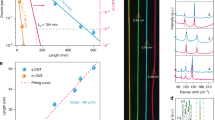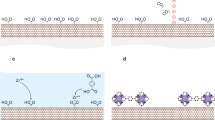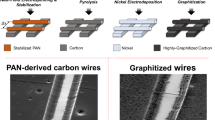Abstract
Among the remarkable variety of semiconducting nanomaterials that have been discovered over the past two decades, single-walled carbon nanotubes remain uniquely well suited for applications in high-performance electronics, sensors and other technologies. The most advanced opportunities demand the ability to form perfectly aligned, horizontal arrays of purely semiconducting, chemically pristine carbon nanotubes. Here, we present strategies that offer this capability. Nanoscale thermocapillary flows in thin-film organic coatings followed by reactive ion etching serve as highly efficient means for selectively removing metallic carbon nanotubes from electronically heterogeneous aligned arrays grown on quartz substrates. The low temperatures and unusual physics associated with this process enable robust, scalable operation, with clear potential for practical use. We carry out detailed experimental and theoretical studies to reveal all of the essential attributes of the underlying thermophysical phenomena. We demonstrate use of the purified arrays in transistors that achieve mobilities exceeding 1,000 cm2 V−1 s−1 and on/off switching ratios of ∼10,000 with current outputs in the milliamp range. Simple logic gates built using such devices represent the first steps toward integration into more complex circuits.
This is a preview of subscription content, access via your institution
Access options
Subscribe to this journal
Receive 12 print issues and online access
$259.00 per year
only $21.58 per issue
Buy this article
- Purchase on Springer Link
- Instant access to full article PDF
Prices may be subject to local taxes which are calculated during checkout






Similar content being viewed by others
References
Franklin, A. D., Lin, A., Wong, H. S. P. & Chen, Z. Current scaling in aligned carbon nanotube array transistors with local bottom gating. IEEE Electron. Dev. Lett. 31, 644–646 (2010).
Zhou, X., Park, J-Y., Huang, S., Liu, J. & McEuen, P. L. Band structure, phonon scattering, and the performance limit of single-walled carbon nanotube transistors. Phys. Rev. Lett. 95, 146805 (2005).
Kang, S. J. et al. High-performance electronics using dense, perfectly aligned arrays of single-walled carbon nanotubes. Nature Nanotech. 2, 230–236 (2007).
Kocabas, C. et al. Radio frequency analog electronics based on carbon nanotube transistors. Proc. Natl Acad. Sci. USA 105, 1405–1409 (2008).
Nougaret, L. et al. 80 GHz field-effect transistors produced using high purity semiconducting single-walled carbon nanotubes. Appl. Phys. Lett. 94, 243505 (2009).
Wang, C. et al. Extremely bendable, high-performance integrated circuits using semiconducting carbon nanotube networks for digital, analog, and radio-frequency applications. Nano Lett. 12, 1527–1533 (2012).
Cao, Q. et al. Medium-scale carbon nanotube thin-film integrated circuits on flexible plastic substrates. Nature 454, 495–500 (2008).
Sun, D-M. et al. Flexible high-performance carbon nanotube integrated circuits. Nature Nanotech. 6, 156–161 (2011).
Snow, E. S., Perkins, F. K., Houser, E. J., Badescu, S. C. & Reinecke, T. L. Chemical detection with a single-walled carbon nanotube capacitor. Science 307, 1942–1945 (2005).
Arnold, M. S., Green, A. A., Hulvat, J. F., Stupp, S. I. & Hersam, M. C. Sorting carbon nanotubes by electronic structure using density differentiation. Nature Nanotech. 1, 60–65 (2006).
Green, A. A. & Hersam, M. C. Nearly single-chirality single-walled carbon nanotubes produced via orthogonal iterative density gradient ultracentrifugation. Adv. Mater. 23, 2185–2190 (2011).
Zheng, M. & Semke, E. D. Enrichment of single chirality carbon nanotubes. J. Am. Chem. Soc. 129, 6084–6085 (2007).
Liu, H., Nishide, D., Tanaka, T. & Kataura, H. Large-scale single-chirality separation of single-wall carbon nanotubes by simple gel chromatography. Nature Commun. 2, 1–8 (2011).
Wu, J. et al. Short channel field-effect transistors from highly enriched semiconducting carbon nanotubes. Nano Res. 5, 388–394 (2012).
Krupke, R., Hennrich, F., van Löhneysen, H. & Kappes, M. M. Separation of metallic from semiconducting single-walled carbon nanotubes. Science 301, 344–347 (2003).
Tu, X., Manohar, S., Jagota, A. & Zheng, M. DNA sequence motifs for structure-specific recognition and separation of carbon nanotubes. Nature 460, 250–253 (2009).
Li, X. et al. Langmuir−Blodgett assembly of densely aligned single-walled carbon nanotubes from bulk materials. J. Am. Chem. Soc. 129, 4890–4891 (2007).
Engel, M. et al. Thin film nanotube transistors based on self-assembled, aligned, semiconducting carbon nanotube arrays. ACS Nano 2, 2445–2452 (2008).
LeMieux, M. C. et al. Self-sorted, aligned nanotube networks for thin-film transistors. Science 321, 101–104 (2008).
Wang, C., Ryu, K., Badmaev, A., Zhang, J. & Zhou, C. Metal contact engineering and registration-free fabrication of complementary metal–oxide semiconductor integrated circuits using aligned carbon nanotubes. ACS Nano 5, 1147–1153 (2011).
Patil, N. et al. Wafer-scale growth and transfer of aligned single-walled carbon nanotubes. IEEE Trans. Nanotechnol. 8, 498–504 (2009).
Zhou, W., Rutherglen, C. & Burke, P. Wafer scale synthesis of dense aligned arrays of single-walled carbon nanotubes. Nano Res. 1, 158–165 (2008).
Kocabas, C., Kang, S. J., Ozel, T., Shim, M. & Rogers, J. A. Improved synthesis of aligned arrays of single-walled carbon nanotubes and their implementation in thin film type transistors. J. Phys. Chem. C 111, 17879–17886 (2007).
Huang, H., Maruyama, R., Noda, K., Kajiura, H. & Kadono, K. Preferential destruction of metallic single-walled carbon nanotubes by laser irradiation. J. Phys. Chem. B 110, 7316–7320 (2006).
Collins, P. G., Arnold, M. S. & Avouris, P. Engineering carbon nanotubes and nanotube circuits using electrical breakdown. Science 292, 706–709 (2001).
Balasubramanian, K., Sordan, R., Burghard, M. & Kern, K. A selective electrochemical approach to carbon nanotube field-effect transistors. Nano Lett. 4, 827–830 (2004).
Banerjee, S. & Wong, S. S. Demonstration of diameter-selective reactivity in the sidewall ozonation of SWNTs by resonance Raman spectroscopy. Nano Lett. 4, 1445–1450 (2004).
Hu, H. et al. Sidewall functionalization of single-walled carbon nanotubes by addition of dichlorocarbene. J. Am. Chem. Soc. 125, 14893–14900 (2003).
Pop, E. The role of electrical and thermal contact resistance for Joule breakdown of single-wall carbon nanotubes. Nanotechnology 19, 295202 (2008).
Javey, A. et al. High-field quasiballistic transport in short carbon nanotubes. Phys. Rev. Lett. 92, 106804 (2004).
Xiao, J. et al. Alignment controlled growth of single-walled carbon nanotubes on quartz substrates. Nano Lett. 9, 4311–4319 (2009).
Liao, A., Zhao, Y. & Pop, E. Avalanche-induced current enhancement in semiconducting carbon nanotubes. Phys. Rev. Lett. 101, 256804 (2008).
Liao, A. et al. Thermal dissipation and variability in electrical breakdown of carbon nanotube devices. Phys. Rev. B 82, 205406 (2010).
Ryu, K. et al. CMOS-analogous wafer-scale nanotube-on-insulator approach for submicrometer devices and integrated circuits using aligned nanotubes. Nano Lett. 9, 189–197 (2008).
Davis, S. H. Thermocapillary instabilities. Annu. Rev. Fluid Mech. 19, 403–435 (1987).
Dai, J. et al. Molecular glass resists for high-resolution patterning. Chem. Mater. 18, 3404–3411(2006).
Islam, A. E. et al. Effect of variations in diameter and density on the statistics of aligned array carbon-nanotube field effect transistors. J. Appl. Phys. 111, 054511 (2012).
Saito, R., Dresselhaus, G. & Dresselhaus, M. S. Physical Properties of Carbon Nanotubes (World Scientific, 1998).
Varesi, J. & Majumdar, A. Scanning Joule expansion microscopy at nanometer scales. Appl. Phys. Lett. 72, 37–39 (1998).
Grosse, K. L., Bae, M-H., Lian, F., Pop, E. & King, W. P. Nanoscale Joule heating, Peltier cooling and current crowding at graphene–metal contacts. Nature Nanotech. 6, 287–290 (2011).
Wulf, M., Michel, S., Jenschke, W., Uhlmann, P. & Grundke, K. A new method for the simultaneous determination of surface tension and density of polymer melts. Phys. Chem. Chem. Phys. 1, 3899–3903 (1999).
Shulaker, M. et al. Linear increases in carbon nanotube density through multiple transfer technique. Nano Lett. 11, 1881–1886 (2011).
Kang, S. J. et al. Printed multilayer superstructures of aligned single-walled carbon nanotubes for electronic applications. Nano Lett. 7, 3343–3348 (2007).
Wang, C. et al. Synthesis and device applications of high-density aligned carbon nanotubes using low-pressure chemical vapor deposition and stacked multiple transfer. Nano Res. 3, 831–842 (2010).
Maria, J., Malyarchuk, V., White, J. & Rogers, J. A. Experimental and computational studies of phase shift lithography with binary elastomeric masks. J. Vac. Sci. Technol. B 24, 828–835 (2006).
Jin, S. H. et al. Sources of hysteresis in carbon nanotube field-effect transistors and their elimination via methylsiloxane encapsulants and optimized growth procedures. Adv. Funct. Mater. 22, 2276–2284 (2012).
Kim, W et al. Hysteresis caused by water molecules in carbon nanotube field-effect transistors. Nano Lett. 3, 193–198 (2003).
Hur, S-H. et al. Organic nanodielectrics for low voltage carbon nanotube thin film transistors and complementary logic gates. J. Am. Chem. Soc. 127, 13808–13809 (2005).
Weitz, R. T. et al. High-performance carbon nanotube field effect transistors with a thin gate dielectric based on a self-assembled monolayer. Nano Lett. 7, 22–27 (2007).
Jin, S. H. et al. Pentacene OTFTs with PVA gate insulators on a flexible substrate. J. Kor. Phys. Soc. 44, 181–184 (2004).
Acknowledgements
The authors thank C. Lee, M. Losego and D. Cahill for their help with materials characterization. The work at University of Illinois was supported by a grant from the Materials Structures and Devices (MSD) program of the Semiconductor Research Corporation and Northrop Grumman. The facilities were supported by the US Department of Energy, Division of Materials Sciences (award no. DEFG02-91ER45439), through the Frederick Seitz MRL and Center for Microanalysis of Materials at the University of Illinois at Urbana-Champaign. S.N.D. acknowledges support from a National Science Foundation Graduate Research Fellowship.
Author information
Authors and Affiliations
Contributions
S.H.J., S.N.D. and J.A.R. conceived and designed the experiments. S.H.J., S.N.D., X.X., A.I., J.K., F.D., J.S., J.F., M.M., E.C. and K.G. performed the experiments. J.S., C.L., Y.L., F.X., M.A.W., M.A.A. and Y.H. performed modelling and simulations. E.P., M.A.A., B.K., Y.H. and J.A.R. provided technical guidance. S.H.J., S.N.D., X.X., J.S., Y.H. and J.A.R. analysed the experiments and simulations. S.H.J., S.N.D., J.S. and J.A.R. wrote the manuscript.
Corresponding author
Ethics declarations
Competing interests
The authors declare no competing financial interests.
Supplementary information
Supplementary information
Supplementary information (PDF 0 kb)
Supplementary movie S1
Supplementary movie S1 (WMV 4363 kb)
Rights and permissions
About this article
Cite this article
Jin, S., Dunham, S., Song, J. et al. Using nanoscale thermocapillary flows to create arrays of purely semiconducting single-walled carbon nanotubes. Nature Nanotech 8, 347–355 (2013). https://doi.org/10.1038/nnano.2013.56
Received:
Accepted:
Published:
Issue Date:
DOI: https://doi.org/10.1038/nnano.2013.56
This article is cited by
-
The future transistors
Nature (2023)
-
Biotemplated precise assembly approach toward ultra-scaled high-performance electronics
Nature Protocols (2023)
-
Pave the way to the batch production of SWNT arrays for carbon-based electronic devices
Nano Research (2023)
-
Emerging Internet of Things driven carbon nanotubes-based devices
Nano Research (2022)
-
Carbon nanotube transistor technology for More-Moore scaling
Nano Research (2021)



